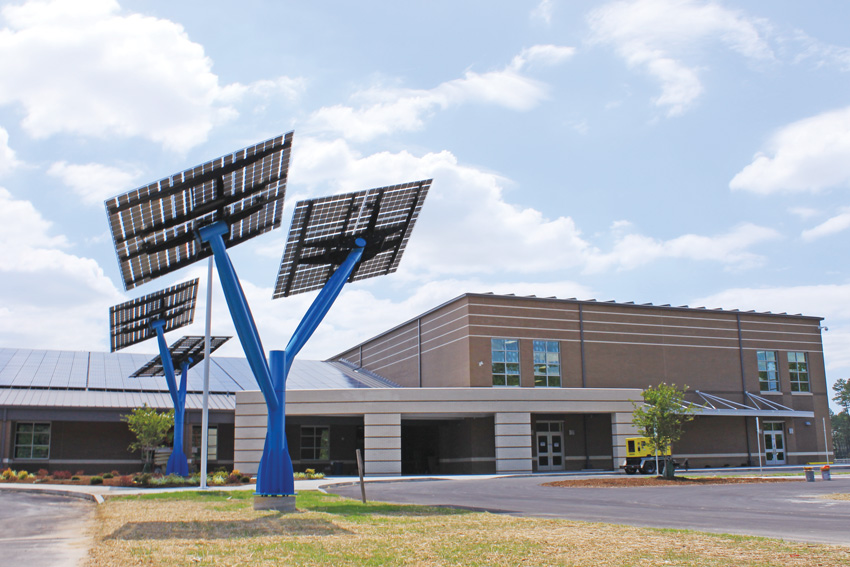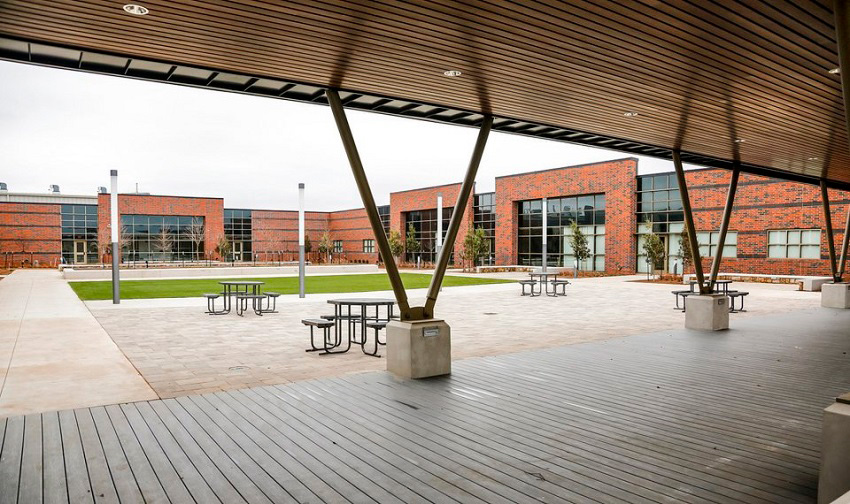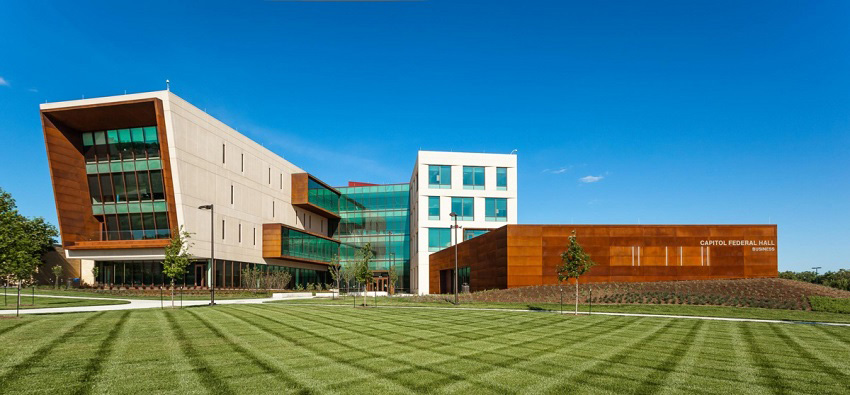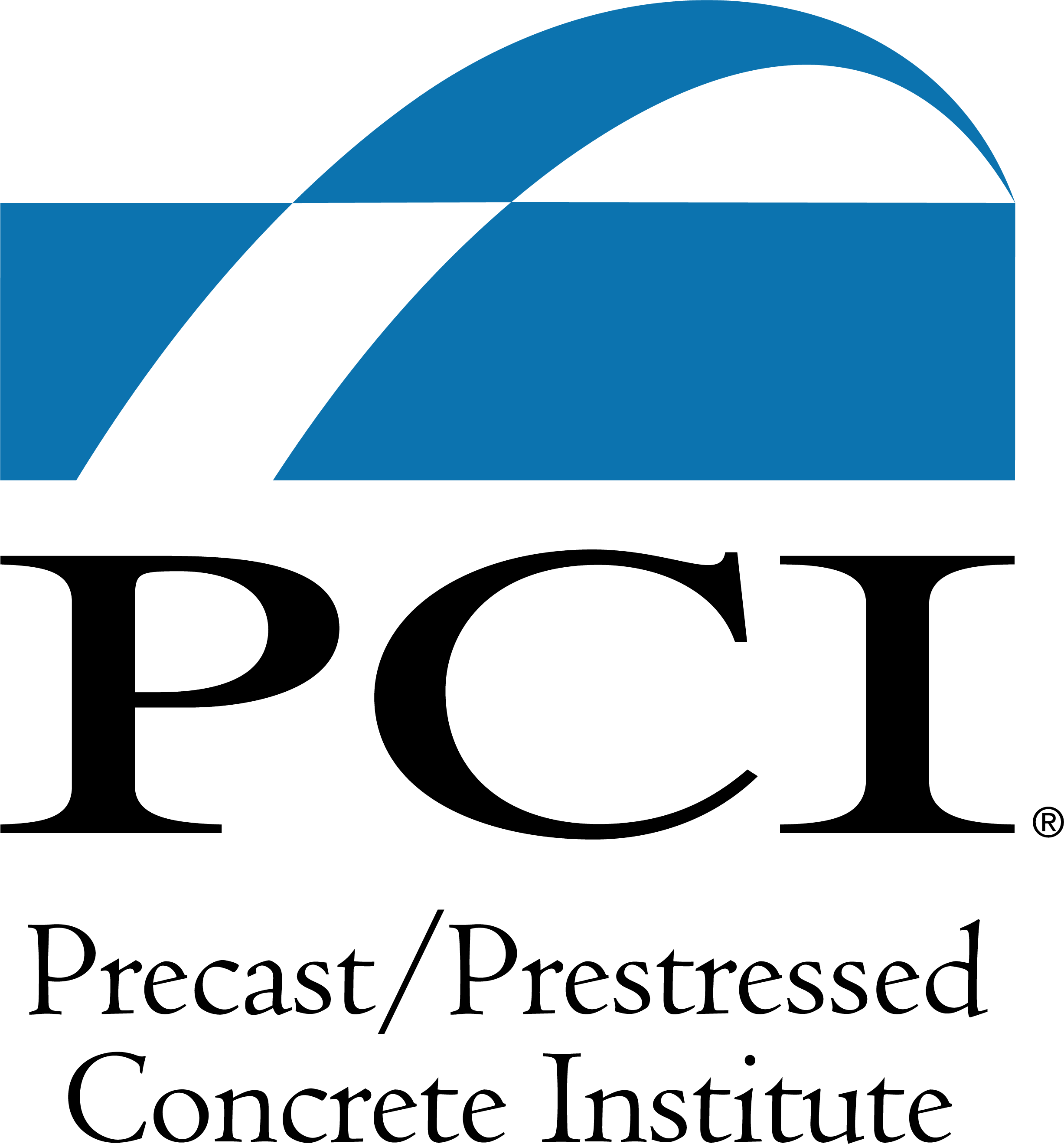This CE Center article is no longer eligible for receiving credits.
Concrete is an ancient material, with gypsum mortars found everywhere from the pyramids of Egypt to the remarkable hard lime mortars of early Greece and the Great Wall of China. The same benefits that attracted these civilizations to concrete as a medium for building—its performance capabilities, resilience, and versatility—have propelled it into a large and increasingly innovative role in today’s construction industry.
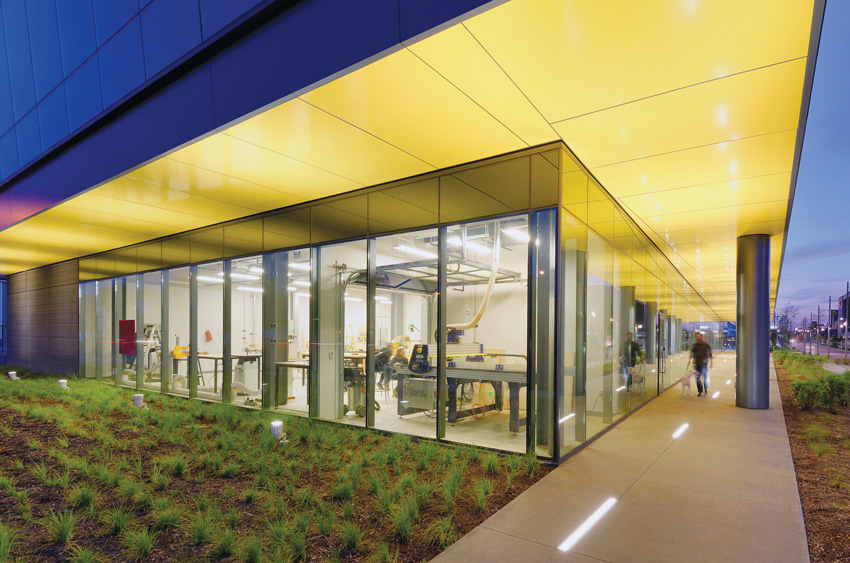
Photo: © Architectural Imageworks
The Cortex Innovation Community is home to a vibrant 200-acre innovation hub and technology district in the historic Central West End of St. Louis. When the owners decided to build an additional mixed-use structure that could act as a gateway to the hub, they wanted to create a building that would measure up to the nationally ranked universities and medical centers in the surrounding neighborhood while achieving pedestrian scale to invigorate a walkable community.
Contemporary precast concrete consists of a mixture of cement, water, aggregate, and optional admixtures that is cast off-site into specific shapes in a controlled environment. The concrete is poured into a form, or mold, and cured before being stripped from the form. These components are then transported to the construction site for erection into place. Precast concrete is reinforced with either conventional reinforcing bars, strands of high-tensile-strength steel, or a combination of both. Prestressing is a method of reinforcement where the steel strands are pretensioned in the form before the concrete is cast. The compressive force created by the strands allows precast elements to span greater distances and carry more load. Prestressing also reduces cracks since the members are in compression.
While modern methods and techniques have enhanced aesthetic and performance capabilities, they have also preserved concrete’s original attributes. Precast concrete is an environmentally sound material produced from natural materials. No toxic substances are used or created by its production or use. Controlled manufacturing further enhances environmental soundness by optimizing material use, reducing waste when the panels are made and associated waste on the job site.
Once in place, concrete’s resilience and performance shine. The thermal mass of concrete saves energy year-round. Precast concrete is noncombustible with inherent fire-resistant capability, creating a safe envelope that helps protect personnel, equipment, and the integrity of the structure itself. When used for structural components, precast also eliminates the need and cost of additional fire-proofing measures. Concrete’s high albedo, or ratio of light reflected, has the added quality of reflecting solar heat as well as sunlight, reducing the heat island effect and higher temperatures endemic to urban areas. The resulting lower overall temperatures can make a difference in the amount of electricity consumed in air-conditioning and reduce smog formation, potentially improving air quality in urban areas. In addition, the inherent sound attenuation properties, due to precast concrete’s mass, provide an economical acoustical barrier to exterior or interior noise penetration. The life-safety and tenant benefits provide a potent marketing asset when attracting long-term occupants.
When a building needs extensive remodeling, precast wall panels can be reused and adapted for expansion or new design.

Photo: © Kessler Photography
Owners of the newly expanded Girls Inc. health and wellness facility in Omaha, Nebraska, wanted a design to reflect their mission of being “strong, smart, and bold.” From the beginning, the architect felt the project’s scale, durability, and budget requirements made insulated architectural precast concrete wall panels the obvious choice. The enclosure provides an R-value nearly double what is required by building codes, while the exposed interior wythe of the panel matches the white exterior, eliminating the cost and continual maintenance of painting.
A Catalog of Advantages
Durability and adaptability: Precast concrete panels provide a long service life due to their durable, low-maintenance surfaces. Insulated sandwich panels paired with precast concrete construction also provide the opportunity to move and reuse panels to refurbish the building, rather than tear it down and discard it, should its use or function change.
Thermal mass and energy performance: The thermal mass of concrete allows shifting of peak heating and cooling loads in a structure to help reduce mechanical system requirements and energy consumption throughout the building.
Fire and natural disaster resistance: Concrete is noncombustible and can contain a fire. As a separation wall, precast concrete helps prevent fire from spreading throughout a building or jumping from building to building. Precast concrete also is resistant to wind, hurricanes, and floods and impacts from wind-driven and flood debris.
Air infiltration: Precast concrete panels have negligible air infiltration. Minimizing air infiltration between panels and at floors and ceilings will provide a building with low air infiltration. These effects will lower energy costs and help prevent moisture problems.
Abundant, local materials:Concrete is used in almost every country of the world as a basic building material. Aggregates, about 85 percent of concrete content, are generally low-energy, local, naturally occurring sand and stone. Most precast concrete plants are located within 200 miles of a building site. Using local materials reduces the transportation required to ship heavy building materials and its associated energy and emissions.
Indoor environmental quality: Concrete contains low to negligible volatile organic compounds (VOCs). Polished concrete floors do not require carpeting. Exposed concrete walls do not require finishing materials, eliminating particulates from sanding drywall taped seams.
Inedibility: Vermin and insects cannot destroy concrete because it is pest resistant.
Versatility in use and design: Precast concrete insulated wall panels can be used in both load-bearing and non-load-bearing building applications. The use of precast concrete insulated wall panels for both building envelope and interior applications provides a variety of benefits for architects, owners, and consumers, including resilient designs that are energy efficient and attractive. Precast concrete insulated wall panels can be finished with a wide variety of textures, colors, and even graphic designs.
Architectural precast concrete not only can ensure these general goals are met, but it also provides a myriad of life-cycle and ancillary benefits that are difficult to match with other materials.
Addressing Misperceptions
Understanding the benefits of precast concrete can assist designers in evaluating the impact of precast concrete on the environment and building operation. However, misperceptions about concrete’s cost, weight, difficulties with on-site erection, and connections, as well as the lack of aesthetical versatility of the product, often eliminate concrete from the picture. In particular, outdated and inaccurate perceptions of insulated concrete wall panels—that they are too heavy, not versatile, or do not do much to support sustainability of a structure—mean failure to consider a pioneering set of envelope technologies.
Despite being a building block of some of civilization’s earliest structures, concrete has continued to evolve, and today’s products are anything but ancient. The precast concrete industry is heavily invested in research and development, with current investigative projects touching on everything from 100-year lifespan impacts on individual concrete components to aesthetic finishes, anchorages, and connections and interactions with wind-energy systems.
Performance
Performance does not only encompass simple energy conservation, but, as an asset, a material’s performance also must support whole building and occupant health. Manufacturers of precast concrete systems strive to produce products that solve the needs of architects looking for versatile and energy-efficient load-bearing and non-load-bearing wall systems.
Precast concrete manufacturers produce insulated wall panels that can be used as both structural and non-structural components of a building system. To obtain a range of insulating, or R-values, precast concrete walls may have insulation applied to the back, or the insulation may be incorporated into a sandwich wall panel to reduce heating and cooling costs. The thermal mass inertia of concrete, which is recognized in ASHRAE standards, also reduces peak heating and cooling loads, saving energy year-round by reducing large internal temperature swings.
Concrete is an ancient material, with gypsum mortars found everywhere from the pyramids of Egypt to the remarkable hard lime mortars of early Greece and the Great Wall of China. The same benefits that attracted these civilizations to concrete as a medium for building—its performance capabilities, resilience, and versatility—have propelled it into a large and increasingly innovative role in today’s construction industry.

Photo: © Architectural Imageworks
The Cortex Innovation Community is home to a vibrant 200-acre innovation hub and technology district in the historic Central West End of St. Louis. When the owners decided to build an additional mixed-use structure that could act as a gateway to the hub, they wanted to create a building that would measure up to the nationally ranked universities and medical centers in the surrounding neighborhood while achieving pedestrian scale to invigorate a walkable community.
Contemporary precast concrete consists of a mixture of cement, water, aggregate, and optional admixtures that is cast off-site into specific shapes in a controlled environment. The concrete is poured into a form, or mold, and cured before being stripped from the form. These components are then transported to the construction site for erection into place. Precast concrete is reinforced with either conventional reinforcing bars, strands of high-tensile-strength steel, or a combination of both. Prestressing is a method of reinforcement where the steel strands are pretensioned in the form before the concrete is cast. The compressive force created by the strands allows precast elements to span greater distances and carry more load. Prestressing also reduces cracks since the members are in compression.
While modern methods and techniques have enhanced aesthetic and performance capabilities, they have also preserved concrete’s original attributes. Precast concrete is an environmentally sound material produced from natural materials. No toxic substances are used or created by its production or use. Controlled manufacturing further enhances environmental soundness by optimizing material use, reducing waste when the panels are made and associated waste on the job site.
Once in place, concrete’s resilience and performance shine. The thermal mass of concrete saves energy year-round. Precast concrete is noncombustible with inherent fire-resistant capability, creating a safe envelope that helps protect personnel, equipment, and the integrity of the structure itself. When used for structural components, precast also eliminates the need and cost of additional fire-proofing measures. Concrete’s high albedo, or ratio of light reflected, has the added quality of reflecting solar heat as well as sunlight, reducing the heat island effect and higher temperatures endemic to urban areas. The resulting lower overall temperatures can make a difference in the amount of electricity consumed in air-conditioning and reduce smog formation, potentially improving air quality in urban areas. In addition, the inherent sound attenuation properties, due to precast concrete’s mass, provide an economical acoustical barrier to exterior or interior noise penetration. The life-safety and tenant benefits provide a potent marketing asset when attracting long-term occupants.
When a building needs extensive remodeling, precast wall panels can be reused and adapted for expansion or new design.

Photo: © Kessler Photography
Owners of the newly expanded Girls Inc. health and wellness facility in Omaha, Nebraska, wanted a design to reflect their mission of being “strong, smart, and bold.” From the beginning, the architect felt the project’s scale, durability, and budget requirements made insulated architectural precast concrete wall panels the obvious choice. The enclosure provides an R-value nearly double what is required by building codes, while the exposed interior wythe of the panel matches the white exterior, eliminating the cost and continual maintenance of painting.
A Catalog of Advantages
Durability and adaptability: Precast concrete panels provide a long service life due to their durable, low-maintenance surfaces. Insulated sandwich panels paired with precast concrete construction also provide the opportunity to move and reuse panels to refurbish the building, rather than tear it down and discard it, should its use or function change.
Thermal mass and energy performance: The thermal mass of concrete allows shifting of peak heating and cooling loads in a structure to help reduce mechanical system requirements and energy consumption throughout the building.
Fire and natural disaster resistance: Concrete is noncombustible and can contain a fire. As a separation wall, precast concrete helps prevent fire from spreading throughout a building or jumping from building to building. Precast concrete also is resistant to wind, hurricanes, and floods and impacts from wind-driven and flood debris.
Air infiltration: Precast concrete panels have negligible air infiltration. Minimizing air infiltration between panels and at floors and ceilings will provide a building with low air infiltration. These effects will lower energy costs and help prevent moisture problems.
Abundant, local materials:Concrete is used in almost every country of the world as a basic building material. Aggregates, about 85 percent of concrete content, are generally low-energy, local, naturally occurring sand and stone. Most precast concrete plants are located within 200 miles of a building site. Using local materials reduces the transportation required to ship heavy building materials and its associated energy and emissions.
Indoor environmental quality: Concrete contains low to negligible volatile organic compounds (VOCs). Polished concrete floors do not require carpeting. Exposed concrete walls do not require finishing materials, eliminating particulates from sanding drywall taped seams.
Inedibility: Vermin and insects cannot destroy concrete because it is pest resistant.
Versatility in use and design: Precast concrete insulated wall panels can be used in both load-bearing and non-load-bearing building applications. The use of precast concrete insulated wall panels for both building envelope and interior applications provides a variety of benefits for architects, owners, and consumers, including resilient designs that are energy efficient and attractive. Precast concrete insulated wall panels can be finished with a wide variety of textures, colors, and even graphic designs.
Architectural precast concrete not only can ensure these general goals are met, but it also provides a myriad of life-cycle and ancillary benefits that are difficult to match with other materials.
Addressing Misperceptions
Understanding the benefits of precast concrete can assist designers in evaluating the impact of precast concrete on the environment and building operation. However, misperceptions about concrete’s cost, weight, difficulties with on-site erection, and connections, as well as the lack of aesthetical versatility of the product, often eliminate concrete from the picture. In particular, outdated and inaccurate perceptions of insulated concrete wall panels—that they are too heavy, not versatile, or do not do much to support sustainability of a structure—mean failure to consider a pioneering set of envelope technologies.
Despite being a building block of some of civilization’s earliest structures, concrete has continued to evolve, and today’s products are anything but ancient. The precast concrete industry is heavily invested in research and development, with current investigative projects touching on everything from 100-year lifespan impacts on individual concrete components to aesthetic finishes, anchorages, and connections and interactions with wind-energy systems.
Performance
Performance does not only encompass simple energy conservation, but, as an asset, a material’s performance also must support whole building and occupant health. Manufacturers of precast concrete systems strive to produce products that solve the needs of architects looking for versatile and energy-efficient load-bearing and non-load-bearing wall systems.
Precast concrete manufacturers produce insulated wall panels that can be used as both structural and non-structural components of a building system. To obtain a range of insulating, or R-values, precast concrete walls may have insulation applied to the back, or the insulation may be incorporated into a sandwich wall panel to reduce heating and cooling costs. The thermal mass inertia of concrete, which is recognized in ASHRAE standards, also reduces peak heating and cooling loads, saving energy year-round by reducing large internal temperature swings.
A growing body of research has been performed on concrete’s thermal performance, investigating the potential of annual energy savings.
However, the percentage of energy impact of thermal mass is highly dependent on the local climate.
Energy efficiency and material efficiency go hand in hand with precast concrete. Precast concrete inherently resists natural forces with a totally composite and fully insulated building system that is scalable to specification. A precast concrete building is enclosed as the structure is being erected, thereby limiting the ingress of moisture and mold. Precast concrete additionally provides efficiency in its use of materials, both throughout the construction stage and during the operation of the building. The hard-finished surfaces are easy to maintain. Produced off-site to meet the precise demands of the job, precast brings these additional performance attributes to the table: site efficiency, minimal site disturbance, negligible waste, low life-cycle cost, operational efficiency, computer-aided or assisted design, and risk reduction for trades.
The industry is currently working on research with the U.S. Department of Energy (DOE) to further improve precast wall panels’ energy performance. Previous studies have shown that a major source of air leakage in a building is through the walls and envelope; the DOE has identified precast concrete wall systems as an optimal solution for achieving high levels of energy efficiency because air leakage through a precast insulated wall panel is negligible.
However, erection and treatment of the joints to eliminate thermal bridges can be critical issues.
The industry also is working to bring down the weights of precast insulated wall panel and envelope systems, while reducing the weight and decreasing the thickness of the precast layers within the concrete sandwich panel assembly. Part of the goal of the project is to use high-performance concrete (HPC), which is a different mix design that increases the strength of the concrete through additives while reducing the weight, decreasing the concrete sandwich panels’ thickness. HPC also uses less portland cement, which decreases the embodied energy and, therefore, the panel manufacturing process’s environmental impact. A majority—95 percent—of a building’s energy and environmental impact occurs over the life of the building versus during the manufacturing process. Insulated precast wall panels made of HPC offer a final building solution that reduces a building’s energy consumption over its life right from the beginning during the production process.
Resilience
A resilient structure is one that can withstand whatever natural or man-made disasters life throws at it. To be considered truly resilient, a building’s design and materials must comprehend structural durability; a long service life; functional resilience; multihazard protection; storm, blast, and earthquake resistance; life safety and health measures; passive fire resistance; and satisfaction of applicable FEMA guidelines.
Resilient design is multifaceted and involves long-term thinking about worst-case scenarios as well as more common, everyday wear. The variables that contribute to resilience are complicated, but the big picture is simple: buildings need to be resilient in order to be truly sustainable. A precast concrete building can be both a beautiful and durable structure.
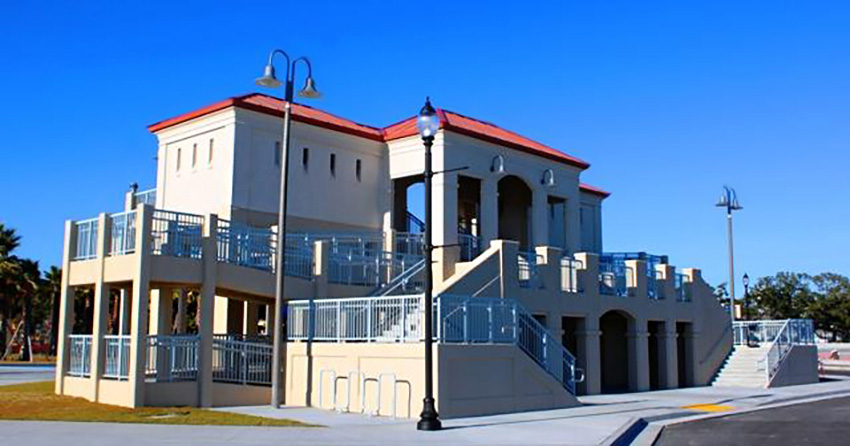
Photo: Courtesy of Gate Precast Company
At the Coast Transit Authority Beach Comfort Stations in Biloxi, Mississippi, an all-precast concrete solution helped meet challenging design requirements while providing a functional and attractive building for the beach-going public. The precast structures withstand 200-mph winds and the high loads resulting from storm surge. Using a total-precast structure gave the team the ability to avoid maintenance on a regular basis due to the precast concrete’s durability.
Structural Durability
A resilient, durable building starts at the building envelope and includes sealing, insulation, and adequate moisture protection. Precast concrete is a multipurpose barrier wall system that can serve as a rainscreen on the exterior and offer an interior finish that dries out if it gets wet and does not require replacement.
Durability, strength, and inherent weather resistance are all natural advantages of precast concrete. The material stands up well to most environmental conditions, retains its appearance over time, and is relatively easy to maintain. Precast concrete structures can be designed for 100-year service life with minimal upkeep. Because precast concrete panels are normally large, the quantity of joints in the building cladding is reduced, meaning fewer areas for leaks to develop over time due to joint failure. Fewer joints also reduce the life-cycle cost of replacing joint sealants and add value to the project for the client.
Resilient structures are very important when it comes to the health, safety, and comfort of a city. Precast concrete does not off gas hazardous substances, whether wet or dry, which improves indoor air quality. Long, clear spans in a precast concrete building provide plentiful daylighting, adding to the well-being of occupants.
Resilience and the Link to Multihazard Protection, Life Safety, and Health
Not only does durability mean superior performance in the face of normal, long-term wear and tear, but it also increasingly means the ability to outlast natural disasters. As the United States has suffered from the brunt of superstorms, hurricanes, earthquakes, floods, and wildfires, resilient design has become a top priority.
For the eastern portion of the country, the most likely natural-disaster scenarios involve water: hurricanes, flooding, storm surges, and blizzards. Buildings are also stressed by the day-to-day impacts from year-round precipitation, high humidity, and extremely dry interiors of heated buildings during winter.
As a building material, concrete is not damaged by water. Concrete submerged in water absorbs small amounts of water over long periods of time, and the water does not damage the concrete. In flood-damaged areas, concrete buildings are often salvageable. Concrete will only contribute to moisture problems in buildings if it is enclosed in a system that does not let it breathe or dry out, and moisture becomes trapped between the concrete and other building materials. For this reason, impermeable wallcoverings should not be used.
During hurricanes, buildings face challenges not only from water but also severe wind and debris. Surge, in which large amounts of water rush over the land and up to buildings, carries with it loose debris that can act as a battering ram against a building. In some cases, if the surge is high enough, the debris can impact the building at heights that were not designed to withstand such force. The inherent strength and hardness of precast will resist these impacts.
In the Western United States, fire, tornadoes, and, of course, seismic considerations become more of a concern.
In fire, precast concrete performs well both as an engineered structure and as a material in its own right. Precast concrete does not burn, and it does not emit any toxic fumes when engulfed by fire. Because of concrete’s inherent material properties, it offers passive resistance and can minimize the fire risk for the lowest initial cost and least maintenance. Precast concrete does not require additional fire protection because it is noncombustible and has slow rate of heat transfer. Precast concrete ensures structural integrity and provides compartmentalization.
Single-family homes are under the greatest danger of destruction during a tornado. In regions of the country where tornados often wreak havoc, precast concrete designs can provide a durable, wind-resistant structure. Several key elements are desired in designing a home or structure to resist tornado damage. These include: connections that securely tie the house together from roof to foundation, providing protection for winds up to 130 mph; impact-resistant roof materials that better withstand high winds and fire; windows and doors with higher wind- and water-design pressure ratings; and construction materials and siting work that eliminate the threat of flood or wildfire.
Furthermore, precast concrete homes provide significantly more protection from wind-borne debris than other building materials, according to tests conducted by the Portland Cement Association. The group tested various walls with the impact of a 2-by-4 wood stud traveling at 100 mph, the equivalent of wind-borne debris during a tornado with 250-mph winds. About 90 percent of tornados have wind speeds of less 150 mph, the group says. Of all materials tested, only the concrete design stopped the debris from penetrating the wall. All others suffered penetration.
A variety of precast concrete components can be used to create tornado-resistant housing. These include foundation walls, load-bearing precast concrete wall panels with an architectural finish, and hollow-core plank for floors and roofing. Precast concrete’s inorganic and noncombustible composition ensure that the housing will not generate mold or mildew following torrential rains, nor will they catch on fire should sparks ignite flammables.
Used at its most basic level as shelter from a storm, precast concrete construction meets all FEMA P-361 criteria for safe rooms. These storm shelters must provide near-absolute protection from wind and wind-blown debris for occupants from extreme events. The design wind speeds chosen by FEMA for safe rooms place an emphasis on life safety. Precast concrete storm shelters withstand wind-borne debris protection for wind speeds up to 250mph.
With the innovative use of special seismic connections, precast concrete structures can withstand an earthquake and maintain critical operations.
So, at its very foundation, a resilient building is one that rolls with the punches. To maximize the future of buildings, they must use materials and construction methods that are durable in the face of natural and man-made events.
Resilient design serves to remind us to design to withstand the test of time.
Versatility
Precast concrete’s ability to adapt to many different functions makes it a favorite of architects, engineers, and contractors alike.
Aesthetics
Precast concrete’s aesthetic versatility allows it to assume virtually any color, form, and texture, facilitating facade integration and historic compatibility. Its off-site, made-to-order production cycle also means scalable performance, economical production, and allows for deconstructive and adaptive resuse.
Precast producers can translate precast concrete to fit whatever goals an architect or designer conceives. Incorporating a variety of colors, textures, and finishes makes each architectural precast concrete project a custom fit. Facade treatment options also include other treatments, such as formliners, reveals, rustications, thin brick, stone, and tile.
Precast concrete building systems are adaptable to a wide variety of orthogonal and radial forms. The array of form possibilities provides nearly limitless creative opportunities. The plasticity of concrete adds to the already enormous range of design opportunities that includes pigments, aggregates, cements, sandblasting, and acid etching.

Photo: © Alessandra Chemollo
The Dior store in Miami was designed to reflect the couture brand’s luxury image of refined elegance, innovation, and a sense of delight. Along with providing the flexibility to achieve the curved panel design, precast concrete also delivered hurricane-resistant performance, which is critical for the waterfront community that regularly faces strong winds, salt air, and heavy rains.
From NFL stadiums, office buildings, schools, data centers, and student housing to retail, prisons, courthouses, and much more, precast concrete can reinvent itself every time it is specified.
Precast concrete walls can be used for both exterior and interior applications. From exposed walls on the interior using insulated precast concrete panels, to a thin-brick veneer on the exterior, to precast concrete stairs, to hollow-core floor slab systems, to the double tees at the roof, to columns and beams, the places precast concrete are found in today’s construction are almost limitless.
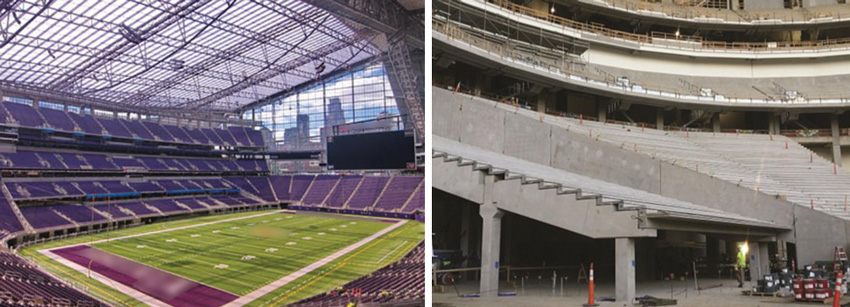
Photos: Courtesy of Wells Concrete
The final design of the U.S. Bank Stadium in Minneapolis features more than 5,000 precast concrete elements that would stretch 27 miles laid end-to-end. All of these pieces were cast at a local Minnesota plant and shipped to the job site in more than 1,500 truckloads. Long precast beams were utilized to minimize the need for columns and beam lines, ensuring great site lines from all seats.
Structure
The outline of a building’s footprint can vary widely depending on several factors, including the zoning, site, and owner preferences. Precast concrete is able to accommodate a wide variety of configurations. The layout of a precast concrete wall system can maximize open areas and create flexible options for floor plans.
Owners today often specify a 100-year life for a structure. When that goal is met with a precast concrete structural system, another benefit is the adaptable shell precast provides, meaning the building can be changed during its decades of service. The structural engineer can create a variety of applications that resist hurricane forces, blasts, and seismic events for all types of buildings.
Tenants move, market conditions vary, personnel may shift, and technology advances. Through the appropriate choice of interior systems and access floors for connectivity, versatile precast concrete structures can accommodate change easily and economically.
Using an open floor plan enables a flexible interior space that can accommodate any number of tenant scenarios. Column-free space allows additional flexibility in floor plans and layouts. Shallow floor thicknesses with few beams provide unobstructed ceiling cavities for mechanical and electrical systems.
From its fluid state in a form to its varied use in and on a structure, precast concrete is adaptable and serves multiple purposes. Whether you value the wide spectrum of colors, textures, and finishes or rely on its stability, strength, and durability, it all comes down to the versatility of precast concrete construction.
Innovation
Harnessing the attributes of concrete, precast concrete wall panel system manufacturers are pressing forward and continuing to innovate, including funding ongoing research and development on various types and weights of insulation and concrete, finishes, and textures. There is also ongoing industry research into thermal bridges and improving erection systems to further improve the systems.
Printing the Future
One of the leading technologies on the horizon for precast concrete is 3-D printing. In partnership with Oak Ridge National Laboratory (ORNL), 3-D printed molds for the architectural precast concrete industry are currently being tested. This technology enables many more castings per mold, reduced production time, and built-in energy-saving features.
This research is part of the precast industry’s desire to modernize its manufacturing techniques, which have experienced minimal changes over the past few decades. Advanced manufacturing can transform the architectural precast industry by developing materials and processes that can reduce the assembly time of complex molds. Current mold manufacturing techniques involve assembling mostly plywood sheets and finishing their surfaces with fiberglass-reinforced coatings. The availability of skilled craftsmen who can do this task has been continuously declining; therefore, precasters have not been able to keep up with technological advances, such as the ability to design complex geometries through building information modeling (BIM). The ultimate goal for the industry is to develop a new mold manufacturing process that takes advantage of the latest technological advances, increasing competitiveness.
Off-site building construction or prefabrication has been gaining momentum because it offers a better product and faster installation than on-site construction. The primary objective of the ORNL project was to demonstrate the viability of using carbon fiber reinforced ABS plastic and the Big Area Additive Manufacturing (BAAM) technology to rapidly manufacture molds for the precast concrete industry.
To this end, ORNL will gather data on the mold manufacturing process, including 3-D printed materials, optimization of mold designs, production time, and mold performance attributes, including durability and quality of concrete surface finish. This information will be compared to data from traditional mold manufacturing techniques. This assessment will de-risk an advanced manufacturing technique that has the potential to be extremely beneficial to the precast industry, as it could reduce the manufacturing time of complex molds by about 50 percent.
The results of the first phase of the study demonstrated that the BAAM process could rapidly manufacture molds suitable for precast concrete manufacturing.
A second phase of this project, currently underway, will focus on exploring more challenging geometries to aid in identifying potential limits of the technology. Researchers at ORNL are evaluating the performance of 3-D printed molds used to precast concrete facades in a 42-story building. Molds are typically handmade from wood and fiberglass coatings, and they must be resurfaced after 20 to 30 pours. A 3-D printed mold could potentially cast up to 200 pieces. “With 3-D printed molds, architects can create complex designs for cornices and columns that they have not previously explored,” ORNL’s Diana Hun says. The research team used large-scale additive manufacturing technology to produce the molds, which are about as large as a queen-size mattress. Industry partners were Gate Precast and Precast Concrete Institute.
Conclusion
Through innovation, precast producers have enhanced the aesthetic and performance capabilities of concrete while preserving its attributes as an environmentally sound and versatile material.
While innovation is enhancing its production process, the benefits of concrete do not end at its creation. Once integrated within a project, concrete’s resilience, versatility, and performance shine. Its durability offers excellent performance day to day but also in the face of extraordinary events, like natural disasters. Resilient design is multifaceted and involves long-term thinking about worst-case scenarios as well as more common, everyday wear. The variables that contribute to resilience are complicated, but the big picture is simple: buildings need to be resilient in order to be truly sustainable. And precast concrete performs. Its performance does not only encompass simple energy conservation but also supports whole building and occupant health.
Performance. Resilience. Versatility. Innovation. The attributes of and new advancements in precast concrete help designers and owners to achieve performance, health, life and safety, and general welfare goals.
Amanda Voss, MPP, is an author, editor, and policy analyst. Writing for multiple publications, she also serves as the managing editor for Energy Design Update.



